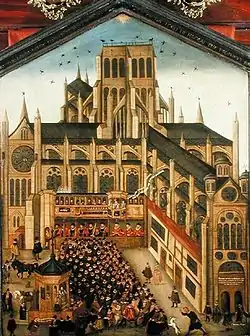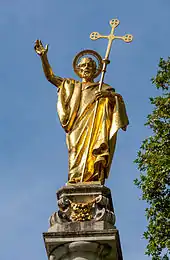St Paul's Cross
St Paul's Cross (alternative spellings – "Powles Crosse") was a preaching cross and open-air pulpit in the grounds of Old St Paul's Cathedral, City of London. It was the most important public pulpit in Tudor and early Stuart England, and many of the most important statements on the political and religious changes brought by the Reformation were made public from here. The pulpit stood in 'the Cross yard', the open space on the north-east side of St. Paul's Churchyard, adjacent to the row of buildings that would become the home of London's publishing and book-selling trade.[1] A monument stands in this area of the Cathedral precinct now, but it is not on the exact spot where Paul's Cross stood. A stone carved with the words 'Here stood Paul's Cross' marks the actual location of the pulpit as it stood from 1449 until 1635, when it was taken down during Inigo Jones' renovation work.

History
Pre-15th century
The eastern half of the Cross churchyard had been controlled by the Corporation in the middle ages: it was the site of the London 'folkmoot' (or general assembly of the people).[2] The earliest folkmoot known to be held here was by John Mansell, a king's justice, on St Paul's Day (29 June) in 1236, to announce that Henry III wished London to be well-governed and its liberties guarded . The Archbishop of Canterbury and the King attended the next such meeting we know of, in 1259, at which Londoners came to swear their allegiance to the latter and to his heirs (though under duress, as a royal army was holding the city gates at this time). They also gathered here later to swear allegiance to Henry's opponent Simon de Montfort.
A Richard Walker from Worcester, a chaplain, pleaded guilty to sorcery charges here in c.1422 but, after forswearing such practices and being arraigned by the Bishop of Llandaff (then John de la Zouche), he was marched to Cheapside with his two magic books open upon him, where the books were burnt and he was freed without any other punishment. Reginald Pecock, Bishop of St. Asaph, attacked Lollardy from this cross in 1447 but himself did public penance there in 1457 (by which time he was Bishop of Chichester) before a mob of 20,000 and the Archbishop of Canterbury, throwing various examples of his own heretical writings into a fire. Thomas Netter also preached against Lollardy here.
Jane Shore, mistress of King Edward IV was brought before the cross in 1483 and divested "of all her splendour".
15th century
Bishop Thomas Kempe rebuilt the cross in the late 15th century in grand architectural form, as an open-air pulpit of mostly timber with room for three or four inside it, set on stone steps with a lead-covered roof and a low surrounding wall.[3]

16th century

For much of the sixteenth and early seventeenth centuries, sermons were preached here on a weekly basis all year round. The preachers were appointed by the bishops of London. For important events or at politically sensitive times, senior clerics (including deans and bishops) would be called on to preach; on less important Sundays, the bishop and his chaplains looked to newly ordained preachers from Oxford and Cambridge, or to local London preachers, to fill the rota. In Queen Elizabeth's reign, it was sometimes difficult to find preachers willing to appear at Paul's Cross.[5] With better funding for the sermon series in the Jacobean period, however, preaching 'at the cross' became a mark of an ambitious young cleric. John Earle's 'bold forward man' would 'if hee bee a scholler ... ha's commonly stept into the Pulpit before a degree; ... and his next Sermon is at Pauls Crosse, and that printed'.[6] Indeed. from the 1580s onwards, it was increasingly usual to print the sermons for distributed to a wider audience; approximately 370 Paul's Cross sermons are now extant, with over 300 titles surviving in print.[7] Because the pulpit stood in one of the few open spaces within an increasingly crowded city, and because royal proclamations were often delivered here, Paul's Cross was the site of several political disturbances in the early modern period. It was a speech here that triggered the 1517 Evil May Day anti-foreigner riots. Ultra-Lutheran Robert Barnes attacked Stephen Gardiner from it, and in 1566 Matthew Hutton, later Archbishop of York, preached here. The first sermon preached here after Catholic Queen Mary's accession (by Bishop Bourne) provoked a riot – a dagger was thrown at Bourne (but missed him, sticking in one of the side posts) and he had to be rushed to safety in St Paul's School. Thus, Mary's successor Elizabeth I kept the pulpit empty for a long time after her accession to keep the people from riot. However, when it finally came to Dr Samson's appearance at the Cross to announce Elizabeth's religious policy, the keys to the Cross's pulpit were found to be mislaid and, when the Lord Mayor ordered the door to be forced, it was found to be too dirty and badly maintained for use on this occasion. However, John Jewel was appointed the Cross's select preacher on 15 June 1559, and on 26 November that year challenged all comers to prove the Roman case out of the Scriptures, or the councils or Fathers for the first six hundred years after Christ.
The end of Paul's Cross
William Dugdale claimed that the pulpit cross was destroyed under the Ordinance for 'Removing monuments of Idolatry' in 1643 at the start of the First English Civil War.[8] Archival evidence demonstrates that the pulpit cross had already been destroyed by 1641, however, and it is most likely that the pulpit was taken down in 1635, when this area of the Cathedral close was used as a masons' yard during renovation work on the Cathedral.[9]
20th century
Between 1908 and 1910 a new structure was erected near the site of Paul's Cross, from funds provided by the will of the barrister Henry Charles Richards. Richards had hoped that the medieval preaching cross would be reconstructed, but the Dean and Chapter of St Paul's Cathedral decided that this would be out of keeping with the architectural setting, Sir Christopher Wren having rebuilt the cathedral in the 17th century. The resulting monument is to a Baroque revival design by Sir Reginald Blomfield, with a statue of Saint Paul by Sir Bertram Mackennal standing on a Doric column of Portland stone. The cathedral authorities' use of Richards's funds aroused a short-lived controversy.[10] In 1972 the monument was listed at Grade II.[11]
 Sir Reginald Blomfield's Paul's Cross
Sir Reginald Blomfield's Paul's Cross The statue of Saint Paul by Sir Bertram Mackennal
The statue of Saint Paul by Sir Bertram Mackennal Plaque on the 20th-century Paul's Cross commemorating its precursor
Plaque on the 20th-century Paul's Cross commemorating its precursor
References
- Blayney, Peter W. M. (1990). The Bookshops in Paul's Cross Churchyard. Bibliographical Society. ISBN 9780948170065.
- Blayney, Peter. "The Bookshop that Never Was, in Lena Cowen Orlin (ed.), Material London ca. 1600 (Philadelphia, 2000), p. 325".
- Wabuda, Susan (2002). Preaching during the English Reformation. New York: Cambridge University Press. pp. 41–3. ISBN 9780521453950.
- John Foxe (1887 republication), Book of Martyrs, Frederick Warne and Co, London and New York, pp. 160–61
- Morrissey, Mary (2011). Politics and the Paul's Cross Sermons, 1558–1642. Oxford University Press. pp. 26–34. ISBN 9780199571765.
- Earle, John (1628). Micocosmographie. London.
- Kirby, Torrance; Stanwood, Paul; King, John; Morrissey, Mary (2017). Sermons at Paul's Cross, 1521–1642. Oxford University Press. ISBN 9780198723615.
- History of St Paul's Cathedral (1658), p. 134
- Morrissey, Politics and the Paul's Cross Sermons, 1558-164 2, p. 34.
- Ward-Jackson, Philip (2003). Public Sculpture of the City of London. Public Sculpture of Britain. Liverpool: Liverpool University Press. pp. 384–6.
- Historic England. "St Paul's Cross (1194637)". National Heritage List for England. Retrieved 25 October 2014.
External links
- Britannia.com
- E. Beresford Chancellor's St. Paul's Cathedral (1925)
- Benjamin Vincent's A Dictionary of Dates, London 1863
